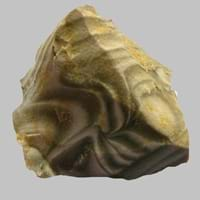Definition
Flint is a hard type of sedimentary rock that produces a small piece of burning material when hit by steel
Lherzolite is a type of ultramafic igneous rock which contains essential olivine and clinopyroxene and orthopyroxene in equal proportions
Discoverer
Unknown
Unknown
Etymology
From Old English flint - a type of rock mainly known for high hardness and for giving off sparks when struck
From the Lherz Massif, an alpine peridotite complex, at Étang de Lers, near Massat in the French Pyrenees; Lherz is the archaic spelling of this location
Class
Sedimentary Rocks
Igneous Rocks
Sub-Class
Durable Rock, Hard Rock
Durable Rock, Hard Rock
Group
Not Applicable
Plutonic
Other Categories
Fine Grained Rock, Opaque Rock
Fine Grained Rock, Opaque Rock
Texture
Banded, Rough
Grenue
Color
Black, Brown, Green, Grey, Red, White
Black, Dark Greenish - Grey, Green, Pink, Purple
Durability
Durable
Durable
Scratch Resistant
Yes
Yes
Appearance
Glassy or Pearly
Glassy, Vesicular and Foilated
Interior Uses
Decorative Aggregates, Homes, Interior Decoration
Decorative Aggregates, Entryways, Homes, Interior Decoration
Exterior Uses
As Building Stone, As Facing Stone, Garden Decoration, Office Buildings, Paving Stone
As Building Stone, As Facing Stone, Office Buildings
Other Architectural Uses
Curbing
Curbing
Construction Industry
Arrowheads, Cutting Tool, Spear Points
Landscaping, Manufacture of Magnesium and Dolomite Refractories, Used for flooring, stair treads, borders and window sills.
Medical Industry
Not Yet Used
Not Yet Used
Antiquity Uses
Artifacts
Artifacts, Sculpture
Commercial Uses
Creating Artwork, Gemstone, In fire-starting tools, Manufacture of tools, Metallurgical Flux, Jewelry, To ignite fire, Used in flintlock firearms
As armour rock for sea walls, Source of Magnesia (MgO), Used in aquariums
Types
Not Available
Garnet Lherzolite
Features
Clasts are smooth to touch, Easily splits into thin plates, Has High structural resistance against erosion and climate
Host Rock for Lead
Archaeological Significance
Monuments
Not Yet Used
Not Yet Used
Famous Monuments
Not Applicable
Not Applicable
Sculpture
Not Yet Used
Used
Famous Sculptures
Not Applicable
Data Not Available
Pictographs
Not Used
Not Used
Petroglyphs
Not Used
Not Used
Figurines
Not Yet Used
Used
Formation
Flint is formed by the decomposition and compaction of various organisms such as sponges and diatoms under the water.
Lherzolite is a fine-grained, hard rock which is a type of metasomatite, essentially altered basalt. It forms with or without crystallization, either below the surface as intrusive rocks or on the surface as extrusive rocks.
Mineral Content
Silicon
Harzburgite, Olivine, Pyroxene, Pyrrhotite
Compound Content
Silicon Dioxide
CaO, Cr, Chromium(III) Oxide, MgO
Types of Metamorphism
Not Applicable
Cataclastic Metamorphism, Contact Metamorphism
Types of Weathering
Not Applicable
Biological Weathering, Chemical Weathering, Mechanical Weathering
Types of Erosion
Chemical Erosion, Coastal Erosion, Water Erosion
Chemical Erosion, Water Erosion, Wind Erosion
Grain Size
Very fine-grained
Fine Grained
Fracture
Conchoidal
Conchoidal
Porosity
Highly Porous
Less Porous
Luster
Vitreous
Subvitreous to Dull
Cleavage
Non-Existent
Perfect
Specific Gravity
2.5-2.8
2.86
Transparency
Translucent to Opaque
Opaque
Density
2.7-2.71 g/cm3
2.8-2.9 g/cm3
Resistance
Heat Resistant, Impact Resistant, Pressure Resistant, Wear Resistant
Heat Resistant, Impact Resistant, Pressure Resistant, Wear Resistant
Deposits in Eastern Continents
Asia
Azerbaijan, China, Russia
Russia, South Korea
Africa
Not Yet Found
Western Africa
Europe
Austria, Belgium, Cyprus, Denmark, France, Germany, Italy, Malta, Netherlands, Poland, Portugal, Romania, Spain, Sweden, Switzerland, Turkey, Ukraine, United Kingdom
United Kingdom
Others
Not Yet Found
Not Yet Found
Deposits in Western Continents
South America
Bolivia
Not Yet Found
Deposits in Oceania Continent
Australia
New Zealand, South Australia
Central Australia, Western Australia
All about Flint and Lherzolite Properties
Know all about Flint and Lherzolite properties here. All properties of rocks are important as they define the type of rock and its application. Flint belongs to Sedimentary Rocks while Lherzolite belongs to Igneous Rocks.Texture of Flint is Banded, Rough whereas that of Lherzolite is Grenue. Flint appears Glassy or Pearly and Lherzolite appears Glassy, Vesicular and Foilated. The luster of Flint is vitreous while that of Lherzolite is subvitreous to dull. Flint is available in black, brown, green, grey, red, white colors whereas Lherzolite is available in black, dark greenish - grey, green, pink, purple colors. The commercial uses of Flint are creating artwork, gemstone, in fire-starting tools, manufacture of tools, metallurgical flux, jewelry, to ignite fire, used in flintlock firearms and that of Lherzolite are as armour rock for sea walls, source of magnesia (mgo), used in aquariums.










